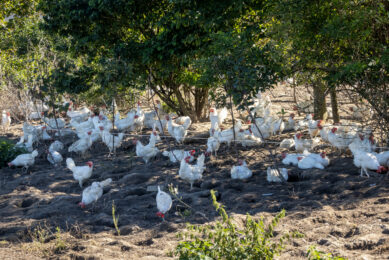Alternative protein sources for poultry diets

The elevated soybean meal price and the need for a sustainable poultry industry increases the need for effective new protein sources with a lower carbon footprint and less land use. This article discusses animal, plant and insect-based alternative protein sources in poultry diets.
Alternative protein sources in poultry diets include animal, plant and insect-based protein sources. Animal-based proteins are high-quality proteins with high digestibility, biological value and a rich amino acid profile compared to plant-based proteins. However, adding enzymes and proper processing improves plant-based proteins’ digestibility and amino acid profile. Insect-based proteins meet poultry requirements in terms of nutritional value, essential amino acid composition, nutrient digestibility and feed acceptance.
ANIMAL-BASED PROTEINS
Blood meal: A by-product of slaughterhouses, is a rich source of lysine, arginine, methionine, cystine, and leucine; however, it contains low glycine and isoleucine. In addition, blood meal is used as a vitamin stabiliser and a source of trace minerals. Inclusion of 1-4% blood meal in poultry diets improves growth performance. Blood meal can be included in poultry diets up to a level of 25%, but supplementing higher levels will negatively impact feed intake and growth performance.
Spray-dried plasma: Produced by the separation of bovine or porcine whole blood into plasma and cell fractions. Spray-dried plasma is a highly digestible protein source with a good amino acid profile. Adding spray-dried plasma to poultry diets improves feed intake, feed efficiency and growth performance.
PLANT-BASED PROTEINS
Sunflower meal: Comprises low concentrations of lysine, phytates and chlorogenic acid, high fibre and non-starch polysaccharides that restrict its use in poultry diet. However, adding methionine and choline to poultry diets reduces the negative impacts of chlorogenic acid. Adding enzymes and digestible lysine to sunflower meal improves bodyweight gain and gain-to-feed ratio. Furthermore, processing dehulled sunflower meal delivers high-protein content with no adverse effects on growth performance.
Cottonseed meal: The protein content of cottonseed meal depends on the extent of dehulling and efficiency of oil extraction. Cottonseed meal contains gossypol, which limits its use in poultry; however, gossypol toxicity can be alleviated through the addition of iron salts and solid-state fermentation. Cottonseed meal in combination with lysine can replace up to 40% of soybean meal protein in broiler diets without any negative effects.
Duckweeds: Are free-floating aquatic plants containing high concentrations of essential amino acids such as lysine and methionine. High nutrient availability and ammonium and nitrate levels enhance duckweed’s crude protein contents by up to 44% in dry matter. Studies suggest that the contribution from fresh or dry duckweed in poultry diets should not exceed 6% of dry matter.
Rice distillers dried grains with solubles
Rice distillers dried grains with solubles, a co-product of the ethanol industry, can be added to laying hen diets at an inclusion level of 10% to improve egg mass, egg production and feed conversion ratio per dozen eggs. In addition, rice distillers dried grains with solubles can be safely added to broiler diets at an inclusion level of 4-5 %.
Rapeseed meal: A by-product of rapeseed, contains 34-38% protein with a well-balanced amino acid profile. The use of rapeseed meal in poultry diets is limited due to the presence of antinutritional factors, glucosinolates and erucic acid. However, solid-state fermentation using Bacillus subtilis and Lactobacillus increases the bioavailability of nutrients and reduces the level of antinutritional factors. Adding rapeseed meal to broilers’ diets improves body weight gain, feed conversion ratio, antioxidant capacity and meat quality, and reduces methane emissions.
Moringa oleifera leaves: Also known as tree of life or miracle tree, contains 95% dry matter, and 22% crude proteins. In addition, moringa oleifera leaves are rich in fats, vitamins, and minerals with growth promoting, immune enhancing and antioxidant activities. Dietary supplementation of moringa leaf powder improves growth performance and health status in broilers. Studies suggest an inclusion level of up to 10% in both broilers’ and laying hens’ diets.
Peanut meal: A source of arginine but deficient in lysine, threonine and methionine. Supplementing peanut meal with threonine increases bodyweight gain and improves feed conversion ratios.
INSECT-BASED PROTEIN
Silkworm pupae meal: Contains 52-72% protein. Replacing up to 50% of the main protein source with silkworm meal is usually safe, though mineral and enzyme supplementation may be required to avoid adverse effects on performance. Adding silkworm pupae meal to laying hen diets lowers the feed conversion ratio and increases bodyweight gain and egg production rates. Adding silkworm pupae meal to broiler diets improves feeding efficiency, bodyweight, feed conversion ratio and dressing percentage.
Black soldier fly larvae: Rich in protein and fat and can be added to laying hen diets with no adverse impacts on egg production. Adding black soldier fly larvae to broiler diets improves bodyweight, feed conversion ratio and feed intake and increases the gut immune function by enhancing IgA.
Earthworm meal: Contains high concentrations of essential amino acids such as lysine. Feeding broilers with a diet containing 3% earthworm meal increases bodyweight gain and improves feed conversion ratios without much effect on feed intake.
Concluding remarks
Dietary supplementation of new protein sources is crucial for a profitable and sustainable poultry industry. The quality of new protein sources can be improved through processing, genetic selection and supplementation with nutrient and non-nutrient additives such as enzymes. New protein sources including animal, plant and insect-based protein sources are promising materials for poultry nutrition, poultry farm profitability and protection of the environment by reducing the carbon footprint of production. However, further research is needed to establish the optimum inclusion level of new proteins based on the various phases of poultry growth to improve health, welfare and production performance.











